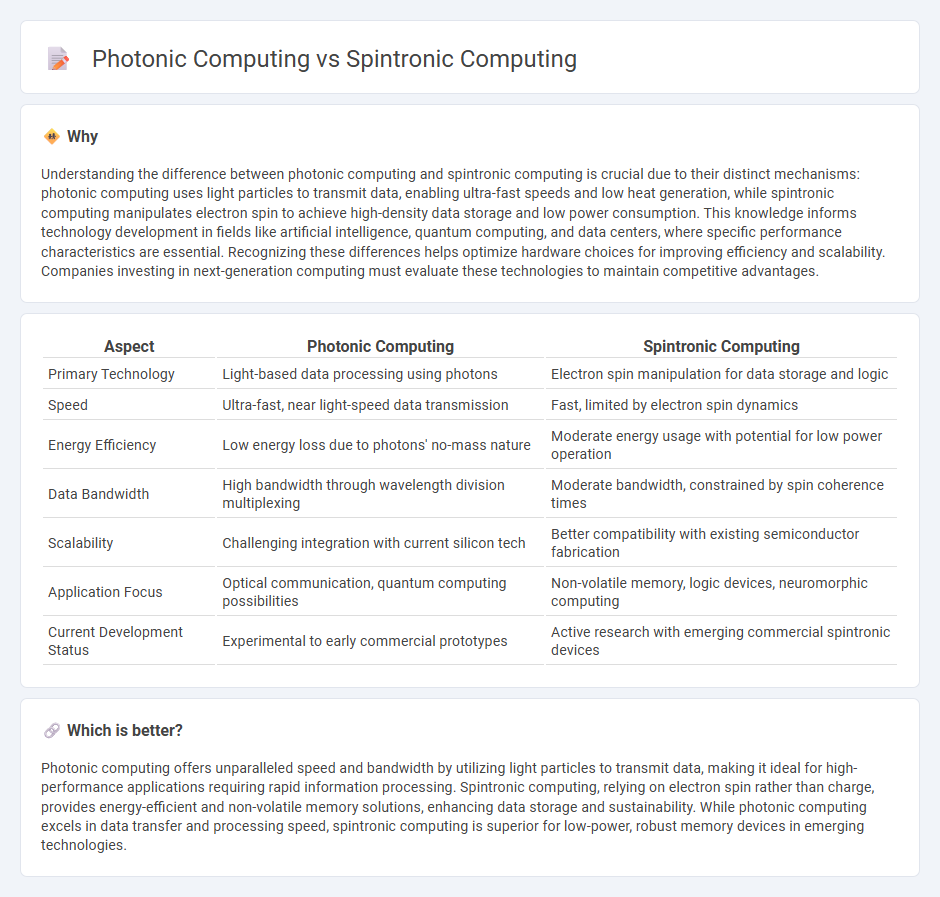
Photonic computing harnesses light particles to perform ultra-fast data processing with minimal heat generation, leveraging photons for parallel information transfer. Spintronic computing exploits electron spin states to enhance data storage and energy efficiency, enabling non-volatile memory with faster access speeds. Explore the distinctions and potential advancements in photonic and spintronic computing technologies.
Why it is important
Understanding the difference between photonic computing and spintronic computing is crucial due to their distinct mechanisms: photonic computing uses light particles to transmit data, enabling ultra-fast speeds and low heat generation, while spintronic computing manipulates electron spin to achieve high-density data storage and low power consumption. This knowledge informs technology development in fields like artificial intelligence, quantum computing, and data centers, where specific performance characteristics are essential. Recognizing these differences helps optimize hardware choices for improving efficiency and scalability. Companies investing in next-generation computing must evaluate these technologies to maintain competitive advantages.
Comparison Table
| Aspect | Photonic Computing | Spintronic Computing |
|---|---|---|
| Primary Technology | Light-based data processing using photons | Electron spin manipulation for data storage and logic |
| Speed | Ultra-fast, near light-speed data transmission | Fast, limited by electron spin dynamics |
| Energy Efficiency | Low energy loss due to photons' no-mass nature | Moderate energy usage with potential for low power operation |
| Data Bandwidth | High bandwidth through wavelength division multiplexing | Moderate bandwidth, constrained by spin coherence times |
| Scalability | Challenging integration with current silicon tech | Better compatibility with existing semiconductor fabrication |
| Application Focus | Optical communication, quantum computing possibilities | Non-volatile memory, logic devices, neuromorphic computing |
| Current Development Status | Experimental to early commercial prototypes | Active research with emerging commercial spintronic devices |
Which is better?
Photonic computing offers unparalleled speed and bandwidth by utilizing light particles to transmit data, making it ideal for high-performance applications requiring rapid information processing. Spintronic computing, relying on electron spin rather than charge, provides energy-efficient and non-volatile memory solutions, enhancing data storage and sustainability. While photonic computing excels in data transfer and processing speed, spintronic computing is superior for low-power, robust memory devices in emerging technologies.
Connection
Photonic computing and spintronic computing intersect through their utilization of quantum properties to enhance information processing efficiency beyond traditional electronic limitations. Photonic computing leverages photons for high-speed, low-energy data transmission, while spintronic computing exploits electron spin states for non-volatile memory and logic operations, enabling faster and more energy-efficient computation. Integration of these technologies aims to develop hybrid systems that capitalize on ultra-fast optical communication and spin-based data storage to overcome current bottlenecks in processing speed and energy consumption.
Key Terms
Electron Spin (Spintronic)
Spintronic computing leverages the intrinsic angular momentum of electrons, known as electron spin, to store and manipulate information with enhanced energy efficiency and faster processing speeds compared to traditional charge-based electronics. This technology offers non-volatile memory capabilities and reduced heat dissipation, making it promising for next-generation computing devices. Explore the fundamental principles and potential applications of spintronics in advancing computing performance.
Photon (Photonic)
Photonic computing utilizes photons instead of electrons to perform data processing, offering significantly higher speeds and bandwidth due to the light particles' ability to travel at the speed of light with minimal heat generation. Spintronic computing relies on electron spin for data manipulation, which is energy-efficient but generally slower compared to photonic systems. Explore more about how photonic computing is shaping the future of ultrafast, energy-efficient technologies.
Quantum Coherence
Spintronic computing leverages electron spin states to maintain quantum coherence for enhanced data processing and storage stability, capitalizing on spin's longer coherence times compared to charge-based systems. Photonic computing utilizes photons for quantum coherence, benefiting from minimal decoherence due to photons' weak interaction with the environment and high-speed signal transmission capabilities. Explore detailed comparisons on how quantum coherence influences performance and scalability in spintronic and photonic computing architectures.
Source and External Links
Spintronics for neuromorphic computing: a breakthrough in energy-efficient information processing - Spintronics research has developed programmable nanodevices, like magnetic tunnel junctions, that can serve as energy-efficient, non-volatile memory and processing units for brain-inspired neuromorphic computing systems.
Spintronic Devices for Energy-efficient Computation - Spintronics uses the electron's spin, not just its charge, to create highly efficient, non-volatile memory and switching devices, with magnetic tunnel junctions (MTJs) acting as the fundamental building block for such computing platforms.
Spintronic Nanodevices for Bioinspired Computing - Spintronics, especially MTJs, enables bioinspired computing with features like embedded non-volatile memory, fast nonlinear dynamics, and tunable stochasticity, offering a path to ultra-high-density, low-energy, adaptive hardware.
 dowidth.com
dowidth.com